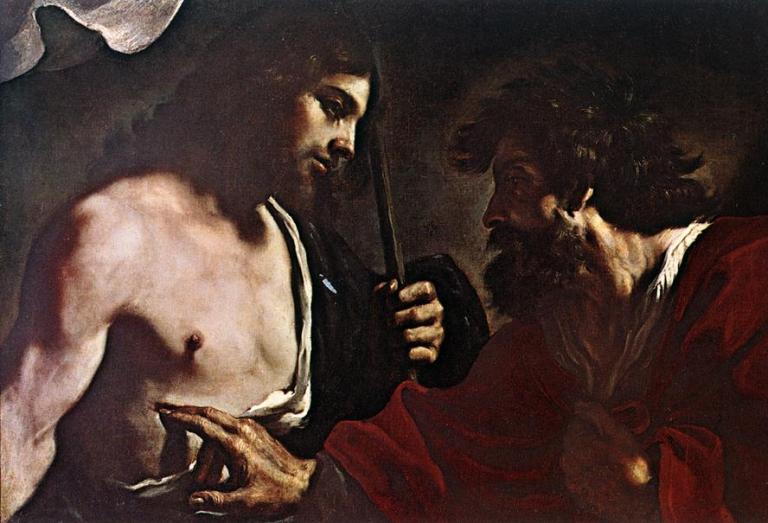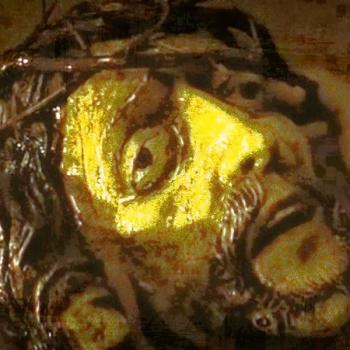
“I won’t believe it unless I see the nail wounds in his hands, put my fingers into them, and place my hand into the wound in his side.” St Thomas
Thomas was one of Jesus’ handpicked Apostles. He reacted to stories of Jesus’ resurrection with sanity.
He didn’t believe it. And he told the people he regarded as fantasists that he didn’t believe it as adamantly as he could.
Thomas was a first century Jew living in a conquered Roman province among people who refused to be conquered. He had almost certainly seen more than his share of how efficient and final a Roman execution was.
Was Thomas in the crowd when Pilate had the beaten shattered remnant of the man Jesus brought out? Behold the man, Pilate said. Jesus, or what was left of Him, stood there, dripping blood from his torn scalp and down the length of his torso. His flesh hung loose in strips and hunks; shredded by the expert application of the flagellum by soldiers who beat people to death for a living.
Did Thomas stand incognito in that crowd that day, or was he hiding somewhere in that big/little town, listening to the roar of the crowd? We know for certain that Thomas ran the night Jesus was taken, ran with the rest of them. We know he never went near Golgotha, that he did not stand at the foot of the cross, that he wasn’t there when they took Jesus’ dead body down from the cross and put it in a grave.
So far as we know, Thomas never deviated from his totally sane, totally human reaction to the Passion and death of his friend. When excited witnesses told him that Jesus had risen from the dead, Thomas stayed true to Thomas. He did what many of us actually do. He reacted with pragmatism and real-world refusal to turn aside from the hard reality of death and accept the wishful fantasy of grief-stricken people.
“I don’t believe it,” he said. And “I won’t believe it unless I see the nail wounds in his hands, put my fingers into them, and place my hand into the wound in his side.”
You’re nuts, he basically told them. Calm down and face facts. Dead is dead and Jesus is dead.
Jesus had told the Apostles and a lot of other people that He was going to go to Jerusalem to be betrayed, crucified and then, after three days, He would rise again. He didn’t just say it once, He said it several times.
He not only told them what was going to happen, He gave them it’s meaning, when He referred to Moses, making an image of a snake and holding it aloft so that the people who looked at it would be healed.
“And as Moses lifted up the serpent in the wilderness, even so must the Son of Man be lifted up, that whoever believes in Him should not perish but have eternal life. For God so loved the world that He gave His only begotten Son, that whoever believes in Him should not perish but have everlasting life. For God did not send His Son into the world to condemn the world, but that the world through Him might be saved.”
Jesus told them that. Thomas heard it. But, when it actually happened as Jesus had said, Thomas didn’t connect the dots.
We call him “doubting Thomas,” but I think he was more absolutely rejecting Thomas.
Thomas was a hard-headed realist, the only modern man in the whole story. He knew that when the Romans killed someone, they stayed dead. He may not have gone to Golgotha and watched Jesus die, but he probably had seen a lot of other people die.
Crucifixion was not only a method of execution, it was meant to be — and was — an effective deterrent. According to historical accounts, the Romans would sometimes line the roads with crosses from which the condemned hung dying in a public display.
Thomas knew that anyone the Romans beat the way they had beaten Jesus was almost certainly going to die from blood loss, shock and infection. He knew that nobody who had had spikes hammered through his ankles and wrists and who then hung for hours with his whole weight on these holes was going to get up and go for a walk three days later. He knew that when a Roman soldier shoves his sword up beneath the rib cage and through the lungs and the pericardium and the heart itself, that person is dead and they are going to stay dead. He knew, as anyone from that era when people died at home and public executions were part of daily life would know, that when the blood separates into its parts of red blood cells and serum and gushes in quantity from a crucified man’s chest that the man is dead, dead, dead.
Thomas wasn’t a bad man. He wasn’t, as future events would demonstrate, a weak man. He was honest and clear-headed. His feet were on the solid ground of reality. He knew the story of Lazarus. He had seen Jesus raise Jairus’ daughter. He witnessed the casual way that Jesus had also raised the young man who was being carried to his grave.
Thomas had seen Jesus calm the sea, give sight to the blind, heal the lame and cast out demons.
He had heard Jesus predict repeatedly that what had just happened was going to happen. He had heard Jesus say “We are going up to Jerusalem, and everything that is written by the prophets about the Son of Man will be fulfilled. He will be turned over to the Gentiles. They will mock him, insult him, spit on him, flog him and kill him. On the third day he will rise again.”
But when witnesses told Thomas that Jesus’ predictions of His own resurrection were true, Thomas didn’t connect the dots. He ignored what he knew about Jesus and believed instead the other things he knew, about crucifixion and the finality of death.
Thomas didn’t doubt Jesus’ resurrection. He denied it. Emphatically.
Thomas was not weak. He was strong. Thomas was not crazy. He was sane. Thomas was rational. Thomas was a realist. Thomas was, as I said, the only modern man in the whole story.
When Thomas saw Jesus Himself, the reality, the concrete aliveness of the man, converted him instantly. “My Lord and my God,” he said.
Thomas traveled all the way to India to preach and teach the story of Jesus and the Resurrection that he himself had denied at first. He was martyred there by a spear thrust through his body and he did not recant.
Thomas, once he saw the Risen Lord, was so convinced of the fact that Jesus has risen from the dead, that he would suffer immense hardship and danger, and ultimately give his life for the Truth he now knew.
That same kind of transformation occurs today to those who doubt and then encounter the Risen Lord. Doubt is normal. Doubt is healthy. Doubt is the nothing to fear if you experience it. Doubt is nothing to fear if you see it in other people.
I can tell you because I have experienced it, that when a doubting, angry, dismissive person turns to Jesus, He can manifest Himself to them with such incredible love and joy that there is no doubt of His reality.
Thomas rejected testimony of Jesus’ resurrection because he was a regular guy who knew that dead is dead and eternal life is an illusion. He was transformed into an Apostle because the Risen Lord came to him and showed him that eternal life is real and death is the illusion.
The same thing happens to us when we experience the Risen Lord.
You don’t need arcane rituals and intercessors to meet the Risen Lord. You don’t need to become all holy and sinless to come to Him. You don’t have to change yourself into something righteous and pure to be acceptable to God. He loves you just like you are. Jesus is the Way to eternal life.
I said, “Forgive me,” and that was all it took.
Doubt is normal. Your doubt is normal.
But when you say “yes” to God in a cry of broken desperation, the answer is immediate and life-changing.













